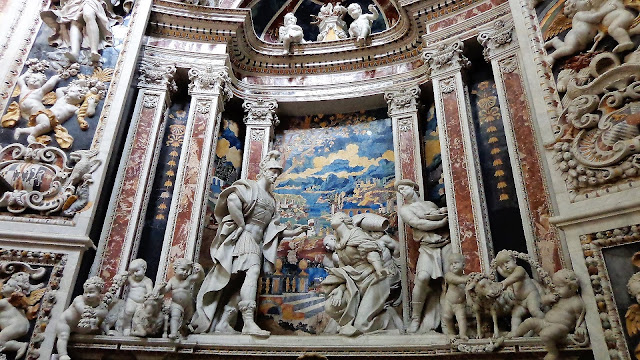The Church of the Gesù, located in Palermo, is considered one of those spectacular early examples of Sicilian baroque in all of Sicily -- and rightly so. Construction on this impressive structure began in 1590 and was finally completed in 1636. The church is considered an early precursor of "Sicilian baroque" which was a distinctive expression of baroque art that developed on the island of Sicily when it was yet under Spanish rule. Many who are familiar with Spanish baroque will know the particular exuberance and ostentatiousness of that particular expression of the baroque, so it should perhaps come as little surprise that Sicilian baroque might take on a similar, but not identical, expressions. In many regards, the art of this church seems like a marriage between the baroque of Rome and that of Spain, sitting somewhere in between the two.
What is particularly impressive about this structure are the ornate reliefs and marble inlays that decorate the various walls of the building. It truly is very much a "jewel box" as one sometimes hears baroque and Rococo art and architecture described, dynamically mixing architectural elements with sculptural and painted into a unified whole. The church, being a Jesuit church, follows a typical Jesuit pattern of a very large and grandiose open nave -- not to mention the inclusions of aspects of the missions within, such as a chapel to the Japanese martyrs.
Immediately behind the high altar is a relief showing the Holy Trinity and to either side are found two scenes taken from the Old Testament which have Eucharistic connotations: one of Ahab and Jezebel in the vineyard of Naboth and the other, of King David being offered holy bread.
 |
| Ahab and Jezebel in the vineyard of Naboth |
 |
| The Nob priest, Achimilech, offering King David holy bread. The work is by the artist Gioacchino Vitagliano |
Everywhere one looks in this church, one comes face to face with all manner of colour and detail. It is too much to detail in point of fact and one could make an essay of each of its chapels, so let's suffice to simply enjoy some further views and details taken from some other parts of the interior:
 |
| The pulpit |
 |
| Chapel of the Sacred heart |
 |
| A good perspective on some of the marble inlays of the church |
 |
| The dome of the chapel of St. Aloysius Gonzaga |


















